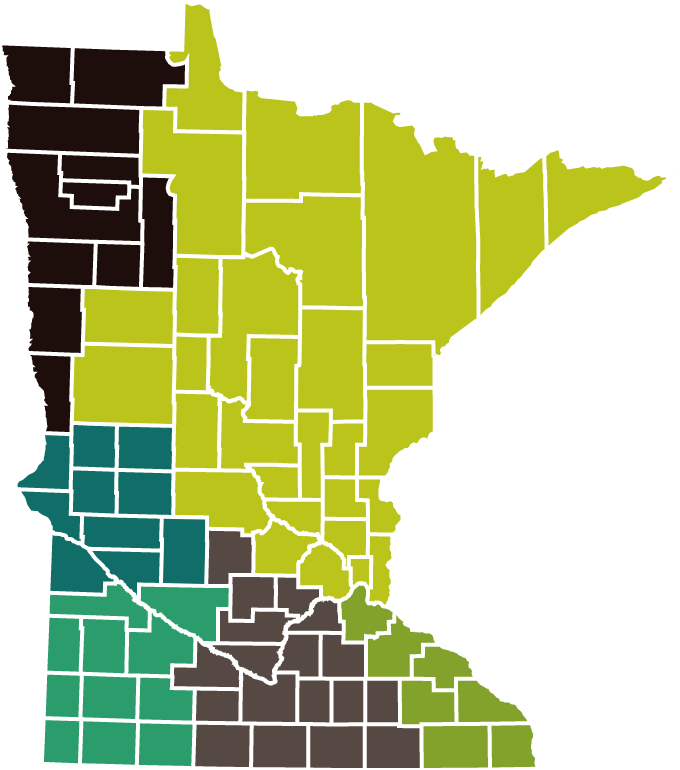AFREC Funded On-Farm Research Trials
Beginning in 2017, AFREC funded an independent agronomist to conduct on-farm trials across the state of Minnesota. Utilizing precision agriculture data that many farmers are already recording, the trials were integrated into each farmer’s existing fertility plan and required minimal extra work and time for the farmer and their advisor.
Work is currently in progress on providing insights from the 2020 trials. Click the button below to view the final report.

2020 Research Trials
In 2020, 25 sites were established to measure corn and soybean yield responses to increased and decreased rates of nitrogen, potassium and sulfur fertilizer among various management zones including low, medium and high yielding areas of fields. There were totals of 14 nitrogen, nine potassium and two sulfur trials. These trials were replicated treatments that are designed to provide sound data. Since these trials only show data from a single year, use the data to show trends and ideas for your crop management decisions, but combine it with other information and experiences from your own farm.
Findings from the 2020 Data
Below are a few key charts and graphs that showcase the results from the 2020 data. These charts are showcasing the raw data simply put into a chart to provide easier analysis and viewing. There are five charts available for display:
- Overall Corn Yield x Application Rate and Type
- Overall Soybean Yield x Application Rate and Type
- Management Zone x Yield
- Yield Change x Increased Fertilizer
- Yield Change x Decreased Fertilizer
The application rates for these trials are as follows below:
- Nitrogen – standard/farmer rate was the MRTN recommended rate and low rate is minus 30 lbs/ac and high rate was plus 30 lbs/ac.
- Sulfur – application rates were 0, 25, and 50 lbs/ac.
- Potassium – standard/farmer rate was the University of Minnesota recommended based on soil test K.
NOTE: to view details of the bars, hover your mouse over the bar to see the number of trials in each data average and other details related to the chart.
CHART 1
The chart above shows the average corn yield performance in bushels per acre in each of the application rate categories measured.
Insights from this graph:
- For nitrogen, trials show a positive yield response with added amounts of nitrogen.
- For nitrogen, trials show a 6.2% yield increase from the low to high fertilizer rate.
- On average for nitrogen applications, a farmer is giving up 5.4 bushels by not applying the high fertilizer rate versus the farmer rate.
- The low nitrogen fertilizer rate is shown to decrease yield results by an over 13 bushels per acre average.
- For potassium, trials show little correlation with rate and yield, in some cases, higher potassium rates could decrease overall yield.
- For sulfur, trials show little correlation with rate and yield, in some cases, higher sulfur rates could decrease overall yield (Note: only two sulfur trials were completed).
CHART 2
The chart above shows the average soybean yield performance in bushels per acre in each of the application rate categories measured.
Insights from this graph:
- Trials show an increase in soybean yield by 3.1 bushels per acre, or by 4.8%, when using the farmer potassium fertilizer rate.
- Trials show a decrease in overall soybean yield when using the high potassium fertilizer rate.
CHART 3
The chart above showcases the average yield performance in bushels per acre of the three application rates from all trials evaluated by the management zone – A, B or C zone.
Insights from this graph:
- Trials show that management zone B produced the highest yield results through all fertility rates.
- On average yielding fields (zone B) growers could gain over 12 bushels per acre when utilizing the high fertilizer rate vs. low fertilizer rate.
- On below average yielding fields (zone C) and above average yielding fields (zone A) there shows to be a negative correlation with yield and applying the farmer fertilizer rate to high fertilizer rate. Decreases from 7.2 to 2.1 bushels per acre are seen.
CHART 4
The chart above shows the deviation in yield performance in bushels per acre for each trial when going from the standard/farmer to high fertilizer rate.
Insights from this graph:
- Across all zones, a higher rate of nitrogen improved yields by 5.4 bushels per acre on average.
- Zones B and C benefitted the most from the higher rate of nitrogen fertilizer.
- Higher rates of combined nitrogen, potassium and sulfur increased yields across all zones by 3.6 bushels per acre on average.
- Zone A benefitted the most from the higher rate of potassium fertilizer.
CHART 5
The chart above shows the deviation in yield performance in bushels per acre for each trial when going from the standard/farmer to low fertilizer rate.
Insights from this graph:
- Across all zones, lower rates of nitrogen, potassium and sulfur decreased yields by 4.6 bushels per acre on average.
- Across all zones, a lower rate of nitrogen decreased yields by 8.2 bushels per acre on average.
- A lower rate of sulfur fertilizer application did not negatively affect overall yield results.
